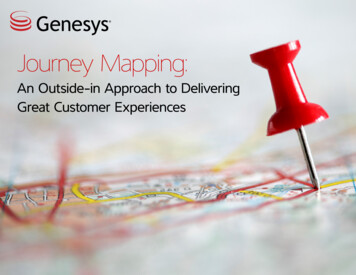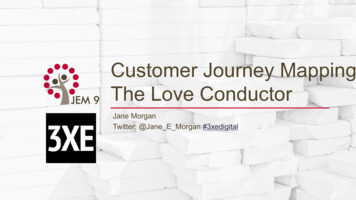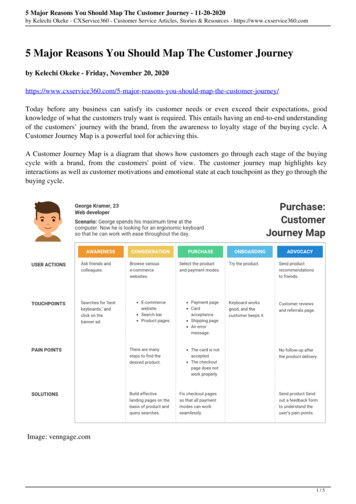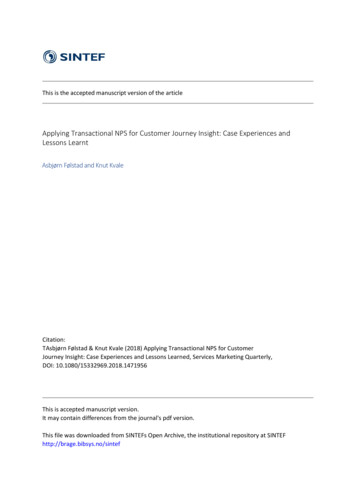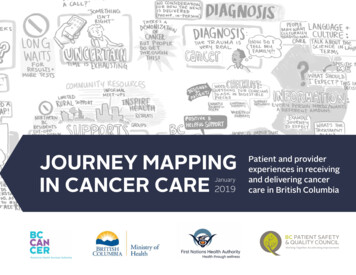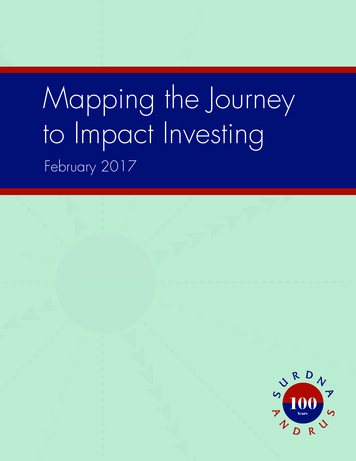
Transcription
A DSML for Customer Journeys in High StreetsData-driven Customer JourneyMapping in Local High Streets:A Domain-specific Modeling LanguageShort PaperC. Ingo BerendesPaderborn UniversityPaderborn, Germanyingo.berendes@upb.deChristian BartelheimerPaderborn UniversityPaderborn, Germanychristian.bartelheimer@upb.deJan H. BetzingUniversity of Muenster, ERCISMünster, Germanyjan.betzing@ercis.deDaniel BeverungenPaderborn UniversityPaderborn, Germanydaniel.beverungen@upb.deAbstractIn high street retail, abundant research has focused on conceptualizing, empirically investigating, and improving customer experience at touchpoints throughout the customerjourney. However, IT—including, smartphones, near-field communication, and broadband access to the Internet—permeates local high streets increasingly and is profoundlytransforming the way in which customer experience is co-created throughout a highstreet customer journey. Current customer experience notations are unable to expresscustomer journeys based on data retrieved from a digitized physical servicescape. Thepurpose of this paper is to design a domain-specific modeling language (DSML) that enables analyzing and designing customer journeys in a digitized high street retail setting.From a design-oriented standpoint, the developed High Street Journey Modeling Language (HSJML) can be used to design and implement online-offline customer journeys indigitized high streets. From an empirical perspective, the HSJML provides the constructsrequired for mapping, analyzing, and predicting online-offline customer journeys in localhigh streets, based on analyzing event-logs from retail platforms.Keywords: Customer Journey Mapping, Customer Experience, Domain-specific Modeling Language, Conceptual Modeling, Business Process ManagementIntroductionCustomer experience is central to both service researchers and practitioners seeking sustainable competitive advantage by focusing on customer value co-creation (McColl-Kennedy et al., 2015; Lemon andVerhoef, 2016; Betzing et al., 2018). Previous research has identified “satisfaction, trust, re-visit intention,re-purchase intention and loyalty [ ] as outcomes of positive customer experience” (McLean et al., 2018,p. 326). Being highly subjective and continuous in nature, the customer experience accrues along the customer journey, a time-logical sequence of touchpoint instances a customer has with one or more serviceproviders and other actors in the purchase process (Halvorsrud et al., 2016; Voorhees et al., 2017).Digital technologies increasingly permeate high street retail and profoundly impact customers’ decisionprocesses and journeys. Customers have myriads of digital and physical touchpoints with retailersThirty Ninth International Conference on Information Systems, San Francisco 20181
A DSML for Customer Journeys in High Streets(Brynjolfsson et al., 2013). Along the purchase process, customers seamlessly switch between digital andphysical channels as well as service providers, sometimes using multiple channels in parallel (e.g., using asmartphone while interacting with a service person), which transforms customer journeys into sequencesof intermingling online and offline service encounters (Haugstveit et al., 2016; Bartelheimer et al., 2018).Albeit the complexity of potential customer journeys increases, so does the amount of digital evidence customers leave behind. Nowadays, high streets see an uptake of local multi-sided digital community platforms, which network local customers, retailers and other high street stakeholders, and provide digital service (Bartelheimer et al., 2018). Instead of performing time- and cost-intensive surveys, customer journeysmight now be inferred and modeled directly from the data collected on these platforms (Betzing, 2018).As opposed to the prospects of data-driven customer journey mapping, traditional customer journey theory(e.g., Shostack, 1987) insufficiently accounts for intermingling online-offline touchpoints, and the perspective of multiple actors (e.g., multiple retailers, intermediaries, other customers), who attribute to the overallhigh street customer experience (Lemon and Verhoef, 2016; Betzing et al., 2018). Likewise, existing notations such as customer journey mapping and service blueprinting (Bitner et al., 2008; Voorhees et al., 2017)fall short of explaining how online-offline customer journeys unfold in digitized physical servicescapes.In line with the dual mission of design science research to advance theory while solving organizationalproblems (Sein et al., 2011), the purpose of this paper is twofold. Our primary research goal is to design aDSML (Frank, 2013) as an IT artifact (March and Smith, 1995) that can be used to model current and designfuture customer journeys in digitized local high streets. On a more abstract level, the DSML might laterevolve into a nascent theory for design and action, prescribing how to design online-offline customer journeys. Second, the DSML departs from current conceptualizations of customer journeys, which view customer journeys as dyadic (as opposed to networked), analog/digital (as opposed to an integrated onlineoffline view), and isolated customer-provider interactions (as opposed to a multi-layered experience that isfocused on the high street as unit of analysis). Our approach, therefore, points at a strong need to updatecurrent theory on customer experience and customer journeys for high streets.The paper unfolds as follows: Section 2 provides a shared understanding of customer journeys. In Section3, we describe our research method. In Section 4, we sketch our High Street Journey Modeling Languageand demonstrate its application in Section 5 with modeling a customer journey in a high street retail scenario. The proposed modeling language is the first notation for modeling and designing complex onlineoffline customer journeys in digitized high streets, as becomes evident from a conceptual comparison withother modeling notations in Section 6. We conclude with an outlook on future research in Section 7.Research BackgroundCustomer JourneysThe customer journey perspective roots in a mind shift in service design and marketing research from assuming what the market wants to develop products and services from a customer’s viewpoint. Since then,scholars evolved the customer journey approach to understand typical customer behavior (Lemon andVerhoef, 2016), to prototype experiential services (Zomerdijk and Voss, 2010; Teixeira et al., 2012), to assess perceived service quality (Halvorsrud et al., 2016; Rosenbaum et al., 2017), and to design for customerexperience (Følstad and Kvale, 2018).As the customer journey terminology is fragmented at best (Rosenbaum et al., 2017) and there exists noontology for the field, we draw from the structured literature reviews contributed by Følstad and Kvale(2018), Heuchert et al. (2018), and Bernard and Andritsos (2017) to establish a shared understanding ofthe core constructs. First, customer experience is the “evolvement of a person’s sensorial, affective, cognitive, relational and behavioral responses to a [service offering] by living through a journey of touchpointsalong prepurchase, purchase and postpurchase situations and continually judging this journey against response thresholds of co-occurring experiences” (Homburg et al., 2015, p. 384). This definition already encompasses many constructs relevant to the customer journey. Table 1 provides the full set of constructs thatare relevant for depicting customer journeys in a digitized world.Thirty Ninth International Conference on Information Systems, San Francisco 20182
A DSML for Customer Journeys in High StreetsTable 1. Constructs for Customer Journeys in a Digitized WorldConstructExplanationCustomer“The stakeholder experiencing a service” (Bernard and Andritsos, 2017, p. 51).ServiceProviderA firm or individual who engages in a business relationship with a customer(Bartelheimer et al., 2018).IntermediaryA facilitator of service encounters between customers and service providers that doesnot take part in the encounter itself (Storbacka et al., 2016; Bartelheimer et al., 2018).CustomerJourneyA time-logical sequence of touchpoints a customer has with one or more service providers and other actors during the purchase process (Halvorsrud et al., 2016; Voorhees etal., 2017; McLean et al., 2018).CustomerJourneyStageA part of the customer journey that groups associated touchpoints. In retail, customerjourneys are often divided into pre-purchase, purchase and post-purchase stages(Lemon and Verhoef, 2016; Bernard and Andritsos, 2017; Heuchert et al., 2018).TouchpointAny instance of discrete interaction between a customer and another actor that is relevant to a service offering (Zomerdijk and Voss, 2010), “including the interaction involving the provision of the service offering itself” (Voorhees et al., 2017, p. 270).TouchpointEventA change of state of an entity, which initiates a touchpoint (Wand and Weber, 1993).Events can arise internal or external to the customer.Event TypeAn abstract class of events with similar properties from which the initiating stakeholderand the channel (i.e., the medium of interaction between two or more actors) can be inferred (Bernard and Andritsos, 2017; Heuchert et al., 2018).TouchpointPreconditionA state that must exist a priori to enable a touchpoint event and the associated touchpoint (Wand and Weber, 1993).Data TraceDigital information that can be transmitted or processed.Related Modeling ApproachesModels are used to reduce the complexity of real-world concepts by only depicting aspects relevant to themodeling goal while neglecting irrelevant information. Customer journey mapping comprises a variety ofpractitioner-driven ways to depict a time-logical sequence of customer touchpoints against a secondary dimension (Følstad and Kvale, 2018). Albeit being very popular in practice, the method is ill-defined in academic literature. Rosenbaum et al. (2017) even named its use a “managerial hodgepodge” (p. 144), wherethe vertical axis (secondary dimension) is used for various purposes such as identifying the organizationalunits responsible for specific touchpoints, customer objectives, and channels. Service management provides more formalized approaches such as service blueprinting (Shostack, 1987; Bitner et al., 2008), multilevel service design (Patrício et al., 2011), and customer experience modeling (Teixeira et al., 2012). However, they focus on service delivery from a single service provider’s view, provide tools for designing complexservice systems, or aggregate customer data in a way that opposes analyzing individual customer journeys.Although we fully acknowledge the relevance and benefits of the existing modeling approaches, we maintainthat no language is capable to model individual online-offline customer journeys as a sequence of eventsperformed by customers and multiple service providers. Consequently, we design a new event-driven DSMLthat is able to depict the central concepts of online-offline customer journeys in high streets. Models designed with the proposed modeling language can be used as an ex-post diagnostic tool to understand individual customer retailing behavior and to capture hints on how different touchpoints and actors contributeto the overall customer experience. Furthermore, it provides a graphical notation of the rather intangible“soft” concepts (Heuchert et al., 2018) in customer experience theory.Thirty Ninth International Conference on Information Systems, San Francisco 20183
A DSML for Customer Journeys in High StreetsResearch MethodIn line with the dual mission of design science (Sein et al., 2011), the approach of this short paper is todesign a DSML as an IT artifact (March and Smith, 1995). A DSML is a modeling language that accountsfor the needs of particular settings since it includes technical terms that constitute a particular domain (e.g.,retail)—such that its users “do not have to reconstruct technical terms on their own” (Frank, 2013, pp. 133134). A DSML has to provide a clear representation of all constructs relevant to the model purpose, whichallow the modeler to create “well-formed statements about the world” (Becker et al., 2014 p. 339). In doingso, DSML foster model quality and comprehensibility of information models (Frank, 2013). Besides fulfilling the requirements for DSMLs by Frank (2013), the objectives of our DSML comprise depicting realworld customer journeys from a data-driven perspective that considers the integrated nature of onlineoffline touchpoints, and that focuses on the high street as the unit of analysis, which comprises touchpointswith multiple actors. To design our DSML, we applied methods from the conceptual modeling literaturethat fall into three steps (Wand and Weber, 1993; Frank, 2013). First, we specify the language’s abstractsyntax by proposing linguistic constructs and modeling rules in a meta-model (Becker et al., 2014). Second,we propose a concrete syntax as a graphical notation (Frank, 2013). Third, we clarify the DSML's semanticsby demonstrating its usefulness to model a customer journey in a local high street. The result of this designprocess is the High Street Journey Modeling Language (HSJML), a DSML with which we can modelonline-offline customer journeys in high street retail settings based on digital evidence.As regards a theoretical contribution that goes beyond the form and function inscribed into the DSML, wecompare HSJML with other approaches that have been proposed for modeling customer journeys. Withthis conceptual evaluation, we show that HSJML currently is the only approach that features modelingconstructs that depart from touchpoint-event-logs in a high street retail setting. While our short paper provides first insights on how online-offline customer journeys in local retail can be conceptualized based ondigital evidence, the approach requires performing an empirical evaluation. To pave the way ahead, wesketch a set of hypotheses that can be tested empirically in our subsequent research (Burton-Jones et al.,2009). Acceptance studies can, on the one hand, identify the DSML’s soundness to model online-offlinecustomer journeys ensuing from event-logs. On the other hand, the language can serve as a coding schemafor data-driven customer journey mapping with data retrieved from digital retail platforms. While HSJMLis primarily motivated from an academic standpoint, empirical studies can reveal how practitioners perceive its ease of use and usefulness with regard to their modeling goals (Recker et al., 2011). Furthermore,we propose that future research on HSJML will eventually enable service providers to predict customerjourneys and to intervene pro-actively at single touchpoints to impact the overall customer experience.A DSML for Online-Offline Customer JourneysAbstract SyntaxThe HSJML takes a holistic, data-driven view on the customer journey. From a sequence of events, boththe customer’s touchpoints and the retailers’ back-stage actions attributing to the journey are derived. Figure 1 provides the meta model of HSJML, depicted as Entity-Relationship-Model in Chen (1976) notation.HSJML depicts singular customer journey instances. The high street service system stakeholders includedin the model are the customer, an intermediary and at least one service provider. The customer’s actionscan be inferred from data traces, and therefore, HSJML does not include any decision nodes or conditionalflows. The customer journey is represented by a time-logical sequence of events, each of which is associatedwith a data trace and a touchpoint. Additionally, each event belongs to an event type that specifies the semantics of the touchpoint. Touchpoints belong to different stages of the customer journey (Lemon andVerhoef, 2016). Preconditions are optional activities that a service provider has to execute beforehand inorder to enable an event and the associated customer touchpoint. Again, data traces denote informationthat different service providers and the customer have provided to the intermediary in the back-stage toenable the customer journey. For each element in the model, additional information can be attributed atdiscretion (this is not depicted in Figure 1 for simplification).Thirty Ninth International Conference on Information Systems, San Francisco 20184
A DSML for Customer Journeys in High StreetsFigure 1. Meta Model of the proposed HSJMLConcrete Syntax / SemanticsThe design of HSJML has been informed by established modeling notations such as BPMN 2.0, from whichwe borrowed pools and lanes as structuring elements (OMG, 2011). A HSJML model consists of one pooleach for the customer, the intermediary, and the service providers involved. The intermediary’s pool isdivided into data lanes facing the customer and the service providers, and a center lane that contains thesequence of identified events for a particular customer journey. The data lanes can be used to depict datatraces between the customer and the intermediary, and between service providers and the intermediary,respectively. Data traces can be added freely without constraints. Each discrete state in the customer journey is depicted in HSJML by a tuple containing an event, a touchpoint, and an optional precondition. Table 2 provides an overview of the representational elements, which are available in HSJML and can be usedto model a customer journey. The sequence flow between events is depicted by directed arrows. Two typesof undirected associations can be used to link an event with data traces and a touchpoint respectively precondition. Touchpoints visualize the interactions between the customer and another actor, as interpretedfrom the triggering event. The touchpoint background is shaded, depending on respective the journey stage.Table 2. Concrete Syntax for HSJMLCustomer,Service Provider,IntermediaryCustomer JourneyTouchpointTouchpoint Event,Event TypeTouchpointPreconditionDemonstration of Utility and Evaluation of Form and FunctionThe scenario used to demonstrate and evaluate the HSJML is taken from the consortium research project“smartmarket²”. Central to smartmarket² is a multi-sided platform, which networks different groups ofactors in high street retail. The platform facilitates touchpoints between these actors and collects event-logdata in the back-stage. A typical high street shopping scenario facilitated by smartmarket² looks as follows:Thirty Ninth International Conference on Information Systems, San Francisco 20185
A DSML for Customer Journeys in High StreetsFigure 2. Exemplary High Street Customer Journey, as Modeled with the HSJMLAt home, Mr. Davis takes his smartphone and opens the smartmarket² app to browse local retailers’ offerings, products, prices, and events taking place in the city center. Quickly, he found interesting productsthat he wants to inspect at a retailer's store, so he organizes his shopping tour on the high street. He passesalong different retailers until he approaches retailer A’s store. A uses beacons, small Bluetooth transponders, which broadcast a signal that can be processed by passersby’s smartphones. Based on the signal, thesmartmarket² app notifies Mr. Davis that retailer A is nearby and provides him with the retailer's offers.However, Mr. Davis is not interested in A’s offers and continues the shopping tour until he passes retailerB, from whom he also receives personalized offers. This time, Mr. Davis is interested and enters the store.In-store, he consults a service person and then purchases the product offered, using a previously receivedmobile discount coupon. Satisfied with the product and the service received, Mr. Davis, later on, writes apositive review on his experience in the smartmarket² app.Figure 2 reconstructs Mr. Davis’ shopping trip using event-log data collected by smartmarket².Conceptual Comparison to Related Modeling ApproachesTable 3. Construct-based Conceptual Comparison of Related Modeling ApproachesLanguageHSJMLBPMN 2.0Sourcethis paper(OMG, 2011)GoalData-driven construction and General processanalysis of customer journeys modelingIndividualIndividualGranularityCustomer Journey MappingService BlueprintingMulti-level ServiceDesignCustomer JourneyModeling Language(Rosenbaum et al.,2017)Service Innovation(Patrício et al., 2011;Teixeira et al., 2012)Service Innovation(Haugstveit et al., 2016)Aggregated(Bitner et al.,2008)Service InnovationBothAggregatedDocumentation and analysis of service deliveryIndividualAvailable y (seq. flow)YesYesYesYesYesNoYesNoYesNoYesPartly (generictasks)YesPartly (only witha focal provider)YesYesYes / PartlyNo / NoNo / NoNo / NoNo /Partly (touchpointsare specialized)NoNoPartly (IT artifacts)NoNoNoNoNoPartly (backstage processes)NoEvents / EventYes / YesTypesDataYesMultiple service providersIntermediaryYesYesPartly (messagesand data objects)Partly (multiplepools)Partly (pool)Partly (support for multiple actors)Partly (support for multiple actors)Thirty Ninth International Conference on Information Systems, San Francisco 20186
A DSML for Customer Journeys in High StreetsWe have shown that HSJML is able depict high street customer journeys as a sequence of events. To demonstrate its superiority for the given application scenario, we compared HSJML to related modeling approaches from different schools of thought (Table 3). All related approaches can be used to visualize customer journeys in high streets but do so only to a limited extent. First, HSJML is the only data-driven approach that shapes customer-specific chains of events from event-logs and, therefore, enables the construction, description, and analysis of individual customer journeys with digital evidence. Second, customer journey mapping and multi-level service design depict expected customer journeys on an aggregated level,where insights from multiple customers are combined. Third, except for BPMN 2.0, the related approachesassume a focal service provider and do not cope with the multi-actor nature of high street retail. HSJMLexplicitly builds on and represents the logic of an intermediary as a facilitator of service encounters (Storbacka et al., 2016). Lastly, BPMN 2.0 is a generic process modeling language, which does not include anydomain-specific customer journey constructs such as stages, touchpoints, and high street events.Contribution, Limitations, and OutlookDigital technologies have profoundly transformed high streets into digital and at the same time physicalservicescapes. New forms of behavioral customer data become available through digital interactions, whichcall for new methods to visualize and describe these online-offline customer journeys on high streets. Inthis short paper, we developed and demonstrated HSJML as a domain-specific modeling language for highstreet retail and conducted a conceptual construct-based analysis vis-á-vis rival modeling approaches.As an IT artifact, HSJML can be used to visualize high street customer journeys. HSJML is the only modeling language that can depict multi-actor, online-offline customer journeys in high streets. As a conceptualtool, the language can be used to conceptualize customer journeys a priori. A posteriori, the language canbe used for data-driven customer journey mapping, analyzing digital evidence recorded on high streets (e.g.,data gathered by intermediaries, such as digital platforms). The resulting models can, therefore, serve as adiagnostic tool to understand, analyze, and predict how individual customers traverse a high street.From a theoretical perspective, HSJML departs from traditional customer journey mapping and customerexperience theory in two ways. First, HSJML is the first modeling language to conceptualize customer journeys with the high street as a unit of analysis, whereas related approaches focus on individual touchpointsor dyadic retailer-customer interactions. Our view implies that stores can be networked with each other,and customers interact with multiple stores while traversing a high street. Second, we conceptualize a customer journey as intermingled online-offline interactions, enabled by a digitized physical servicescape,whereas current theory views customer journeys as consisting of separate online or offline interactions.In subsequent research, we will evaluate the language’s organizational impact in order to develop generalized design knowledge. In particular, we will identify the language’s ability to enable designers to specifycustomer journeys in high streets, and its ability to perform data-driven customer journey mapping for ahigh street as a unit of analysis. Inspired by Burton-Jones et al. (2009) and Recker et al. (2011), the following hypotheses might guide the empirical evaluation of the HSJML for designing and interpreting customerjourneys in digitized local high streets:Hypothesis 1: As regards online-offline customer journey in high streets, HSJML will outperform relatedmodeling languages in terms of representational fidelity, enabling designers to conceptualize effective customer journey maps.Hypothesis 2: As regards online-offline customer journey in high streets, HSJML will outperform relatedmodeling languages in terms of representational efficiency, enabling designers to conceptualize customerjourney maps more efficiently.Hypothesis 3: As regards online-offline customer journey in high streets, HSJML will outperform relatedmodeling languages in terms of interpretational fidelity, enabling stakeholders in a high street to moreeffective understand customer journey maps.Hypothesis 4: As regards online-offline customer journey in high streets, HSJML will outperform relatedmodeling languages in terms of interpretational efficiency, enabling stakeholders in a high street to moreefficiently understand customer journey maps.Thirty Ninth International Conference on Information Systems, San Francisco 20187
A DSML for Customer Journeys in High StreetsSince design is a search process (Hevner et al., 2004), the design of the HSJML comes with limitations.First, as the requirements defined for designing an artifact can never be complete, by definition (Alexander,1964), the current abstract syntax is necessarily non-exhaustive and—just like our short paper—is a snapshot in an ongoing research effort that will be iteratively refined. On the one hand, the evaluation mighthint at the need for conceptual extensions. On the other hand, the set of event types provided is an informedselection that can be freely expanded to cater for other potential events in a journey. Second, currently thereare no modeling tools available that can build HSJML models automatically from event-logs. We rely onhuman coders to interpret event-logs and manually model customer journeys as depicted in Figure 2. Todo so, we provide a set of shapes for the flowcharting tool Microsoft Visio. Third, reconstructing customerjourneys from event-logs requires data to be available for all touchpoints. While multi-sided local community platforms are becoming more common in high street retail, their adoption by customers is hamperedby privacy concerns regarding personal data (Bartelheimer et al., 2018; Betzing, 2018). Moreover, to yieldinsights from non-digitized, physical touchpoints (e.g., interpersonal service), retailers would have to collect information on the service encounters manually. Nevertheless, with ongoing digitalization and platforms that implement and clearly communicate privacy-preserving behavior, larger amounts of event-logdata will become available in the future.Eventually, data-driven customer journey mapping can be realized, where techniques from process miningare applied to analyze event-logs. Data and information from existing customer journey models can be combined with event-logs to discover, conform and enhance customer journeys (van der Aalst, 2016). Insteadof relying on human interpretation to build HSJML models, the models will then be constructed from eventlog data automatically. Bernard and Andritsos (2017) propose a technical representation of customer journeys that serves as input for existing process mining tools such as ProM to derive insights (van der Aalst,2016). However, their approach lacks a domain-specific graphical representation—a gap that HSJMLcloses. Process mining can be used to derive “de facto” models from data, and to compare these models withpreviously established “de jure” models to identify if and how customers respond to provided cues (e.g.,receiving personalized offers through the platform). By aggregating data from multiple customer journeys,metrics such as throughput times and points where customers are often lost can be derived as insights thatdirectly relate to customer experience. Further, transition probabilities might enable predicting the customer’s next moves or even predict whole customer journeys in a high street in real-time. Finally, eventlogs and analyses can be enriched with external data (e.g., weather data) to yield context-savvy insights.To conclude, HSJML provides the foundation for the event-driven construction and visual analysis of customer journeys in high street retail. With the further development of HSJML, the availability of event-logdata, and the adaption of process mining techniques, valuable insights regarding online-offline customerjourneys and customer experience created therein can be derived to advance theory and practice.AcknowledgementsThis paper was developed in the research project smartmarket² (www.smartmarketsquare.de), which isfunded by the German Federal Ministry of Education and Research (BMBF), promotion signs 02K15A07302K15A074. The authors thank the Project Management Agency Karlsruhe (PTKA).ReferencesAlexander, C. (1964). Notes on the Synthesis of Form. Cambridge, MA, USA: Harvard University Press.Bartelheimer, C., J. H. Betzing, I. Berendes, and D. Bever
As opposed to the prospects of data-driven customer journey mapping, traditional customer journey theory (e.g., Shostack, 1987) insufficiently accounts for intermingling online-offline touchpoints, and the perspec-tive of multiple actors (e.g., multiple retailers, intermediaries, other customers), who attribute to the overall


